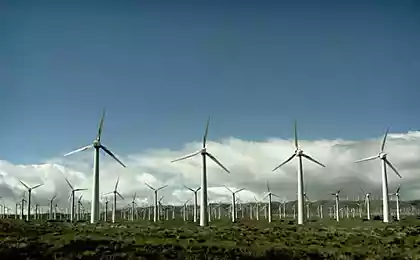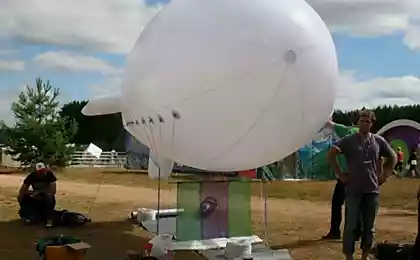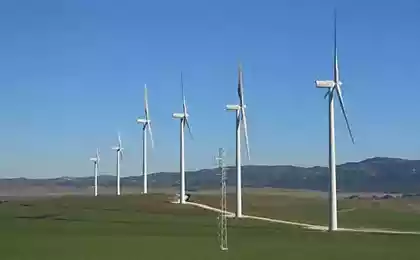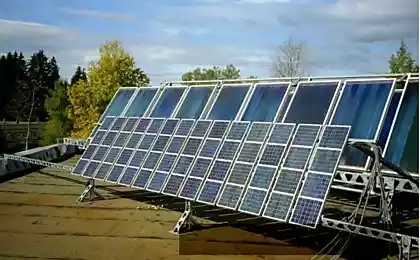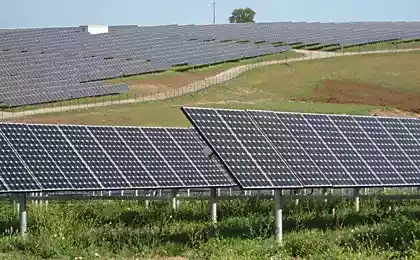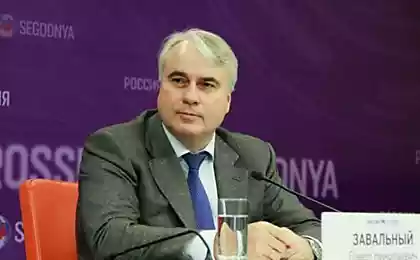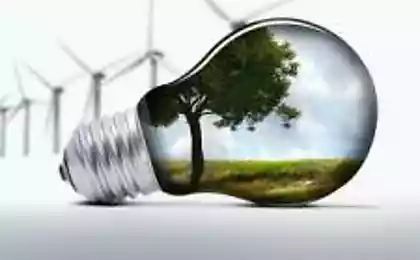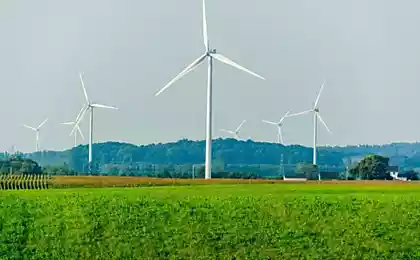615
Generation based on renewable energy will reduce harmful emissions
By signing the Paris agreement to combat global warming in April of this year, Russia, along with other parties to the Convention is obliged to make every effort to prevent the increase in the average temperature of the planet by the year 2100 more than 2 degrees.
By 2020, our country must reduce greenhouse gas emissions by 25 percent from 1990 levels, and by 2030 to reduce emissions by 5 percent. The leading role in this process, of course, belongs to the power industry.
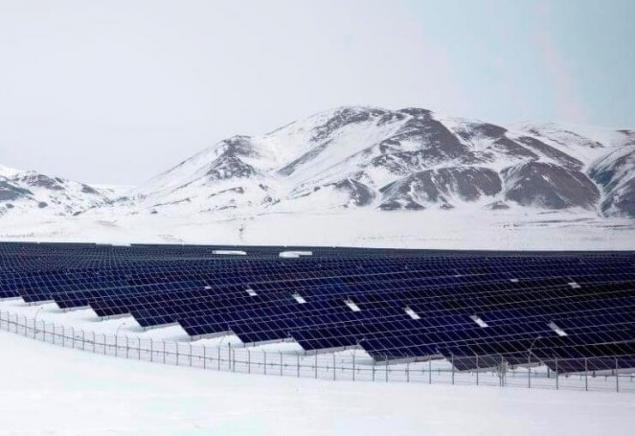
Kosh-Agach SPP-2, Altai Republic
As you know, the generation based on renewable energy sources (RES) is emission-free. Now, however, the share of RES in the total generation barely reach 2 percent. However, according to energy Minister Alexander Novak, by 2035 the share of RES in the energy balance according to the Energy strategy of the Russian Federation should reach 3-4 percent. And when you consider large hydro generation in all the world it relates to renewable energy, then now the share of renewable energy in Russia is more than 18 percent, the Minister said.
However, environmentalists argue that large hydroelectric power stations, though not involved in serious harmful emissions, however, affect the state of the environment and climate in the region. So, after the construction of the Krasnoyarsk hydroelectric power station the water had gone 175 thousand hectares of land, and the Yenisei in the area of the regional center stopped freezing, and the winter air there was very humid. So in terms of hydro power for nature is much "healthier" small HPPs, where the reservoir is a small area, and mining and hydropower, where the landscape provides a drop of water flows to the turbine.
"Russia has a great potential for development of alternative energy. According to the energy Ministry, the volume of technically available resources of renewable energy in the Russian Federation is not less than 24 billion tons of conditional fuel. Thus, developing renewable energy sources, it is important to use individual approach for each region, taking into account such features as the vastness of the territory and diversity of climate zones. Now there are a number of successful pilot projects. For example, the solar heating system are partly used in the Krasnodar region and Buryatia Republic. They can be effectively applied in other regions: in the North Caucasus and the far East, Astrakhan, and Chita oblast, Kalmykia, Tuva, Buryatia. A promising direction is the development of wind energy. Here is a key region is the far East — Yakutia, Kamchatka, Sakhalin," — said CEO of Eaton in Russia and Kazakhstan Tatiana Fantaev.
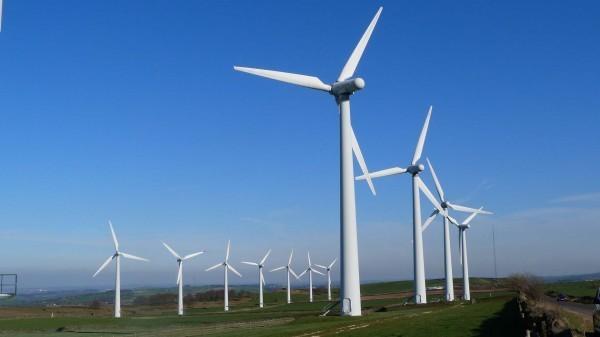
Increasing the share of renewables in the energy mix of the country not just possible, but vital, said the expert of the Analytical center under the government of the Russian Federation Dmitry Khomchenko: "Last year, according to the meteorologist, was the warmest in the hemisphere over the last 120 years. And a considerable contribution to the increase of average temperatures made it the emissions of greenhouse gases, which are actively formed, including the burning of various fossil fuels used to produce heat and electrical energy.
In addition, the development of renewable energy leads to increased energy independence and to improve the environmental situation in the respective territories".
Trends in the global energy sector also indicate that renewable energy will gradually become the leaders in the production of electricity in a sharp rise of investment in their creation and development. The European Union has set a goal of increasing by 2020 the amount of renewable energy to 20 percent of total energy consumption, and for example, Denmark looks forward to 2026 to obtain all the necessary energy exclusively from inexhaustible sources, the expert added.
"Today, many countries have managed to significantly increase the share of alternative energy. For example, in 2015, Costa Rica announced a complete transition to renewable sources, Iceland has also made significant progress, increasing the share of renewable energy to 85 percent," — said Tatiana Fantaev. And in such European countries as Germany, Spain, the share of RES in the energy balance will soon reach half.
According to the energy Ministry in 2013-2015 in the development of alternative energy generation attracted 187 billion rubles of investment, of which 155 billion in solar plants. "Government decree No. 449 dated 28.05.2013 "On the mechanism of stimulation of using renewables in the wholesale market of electric energy and power" gave a strong impetus to the construction of new stations on renewable energy in Russia. Further, it is important to systematically and consistently develop this area to establish in Russia a strong Foundation energy future free from dependence on dwindling fossil fuels" — said "RG" Director of the Solar business of Schneider Electric in Russia and CIS Yuri Kolar.
"Existing support mechanisms for renewable energy aimed at attracting investment in large-scale projects. While in Russia, the huge development potential in the retail segment, and it requires a separate additional mechanisms that would expand the scope of renewable energy among the population, — says the expert on RES Nikolai Popov. For comparison, in Queensland in Australia on the roofs of buildings and structures of 1.47 GW of installed solar systems, which is comparable to the capacity of the largest in Moscow TPP-26 (1.8 GW). Even in countries such as Finland, where the number of Sunny days is small, there is a mechanism that compensates the population of the capital cost of the installation of "rooftop" solar power plants. In the case of the adoption of measures to encourage the population to use renewable energy sources, Russia will receive even greater impetus for the development of high-tech industries will create new jobs, improve the environmental situation in the cities.
According to participants of renewable energy market in Russia in 2015 was set to 8 MW stand-alone solar power plants on the roofs of private households. "This means that approximately 1,600 homes in the past year, switched to an environmentally friendly form of electricity. The main reason for the installation of such systems is the fact that these homes are very expensive or technologically impossible to draw the lines," — said Nikolai Popov. published
P. S. And remember, only by changing their consumption — together we change the world! ©
Source: altenergiya.ru/apologiya/generaciya-na-osnove-vie-snizit-vrednye-vybrosy.html
By 2020, our country must reduce greenhouse gas emissions by 25 percent from 1990 levels, and by 2030 to reduce emissions by 5 percent. The leading role in this process, of course, belongs to the power industry.

Kosh-Agach SPP-2, Altai Republic
As you know, the generation based on renewable energy sources (RES) is emission-free. Now, however, the share of RES in the total generation barely reach 2 percent. However, according to energy Minister Alexander Novak, by 2035 the share of RES in the energy balance according to the Energy strategy of the Russian Federation should reach 3-4 percent. And when you consider large hydro generation in all the world it relates to renewable energy, then now the share of renewable energy in Russia is more than 18 percent, the Minister said.
However, environmentalists argue that large hydroelectric power stations, though not involved in serious harmful emissions, however, affect the state of the environment and climate in the region. So, after the construction of the Krasnoyarsk hydroelectric power station the water had gone 175 thousand hectares of land, and the Yenisei in the area of the regional center stopped freezing, and the winter air there was very humid. So in terms of hydro power for nature is much "healthier" small HPPs, where the reservoir is a small area, and mining and hydropower, where the landscape provides a drop of water flows to the turbine.
"Russia has a great potential for development of alternative energy. According to the energy Ministry, the volume of technically available resources of renewable energy in the Russian Federation is not less than 24 billion tons of conditional fuel. Thus, developing renewable energy sources, it is important to use individual approach for each region, taking into account such features as the vastness of the territory and diversity of climate zones. Now there are a number of successful pilot projects. For example, the solar heating system are partly used in the Krasnodar region and Buryatia Republic. They can be effectively applied in other regions: in the North Caucasus and the far East, Astrakhan, and Chita oblast, Kalmykia, Tuva, Buryatia. A promising direction is the development of wind energy. Here is a key region is the far East — Yakutia, Kamchatka, Sakhalin," — said CEO of Eaton in Russia and Kazakhstan Tatiana Fantaev.

Increasing the share of renewables in the energy mix of the country not just possible, but vital, said the expert of the Analytical center under the government of the Russian Federation Dmitry Khomchenko: "Last year, according to the meteorologist, was the warmest in the hemisphere over the last 120 years. And a considerable contribution to the increase of average temperatures made it the emissions of greenhouse gases, which are actively formed, including the burning of various fossil fuels used to produce heat and electrical energy.
In addition, the development of renewable energy leads to increased energy independence and to improve the environmental situation in the respective territories".
Trends in the global energy sector also indicate that renewable energy will gradually become the leaders in the production of electricity in a sharp rise of investment in their creation and development. The European Union has set a goal of increasing by 2020 the amount of renewable energy to 20 percent of total energy consumption, and for example, Denmark looks forward to 2026 to obtain all the necessary energy exclusively from inexhaustible sources, the expert added.
"Today, many countries have managed to significantly increase the share of alternative energy. For example, in 2015, Costa Rica announced a complete transition to renewable sources, Iceland has also made significant progress, increasing the share of renewable energy to 85 percent," — said Tatiana Fantaev. And in such European countries as Germany, Spain, the share of RES in the energy balance will soon reach half.
According to the energy Ministry in 2013-2015 in the development of alternative energy generation attracted 187 billion rubles of investment, of which 155 billion in solar plants. "Government decree No. 449 dated 28.05.2013 "On the mechanism of stimulation of using renewables in the wholesale market of electric energy and power" gave a strong impetus to the construction of new stations on renewable energy in Russia. Further, it is important to systematically and consistently develop this area to establish in Russia a strong Foundation energy future free from dependence on dwindling fossil fuels" — said "RG" Director of the Solar business of Schneider Electric in Russia and CIS Yuri Kolar.
"Existing support mechanisms for renewable energy aimed at attracting investment in large-scale projects. While in Russia, the huge development potential in the retail segment, and it requires a separate additional mechanisms that would expand the scope of renewable energy among the population, — says the expert on RES Nikolai Popov. For comparison, in Queensland in Australia on the roofs of buildings and structures of 1.47 GW of installed solar systems, which is comparable to the capacity of the largest in Moscow TPP-26 (1.8 GW). Even in countries such as Finland, where the number of Sunny days is small, there is a mechanism that compensates the population of the capital cost of the installation of "rooftop" solar power plants. In the case of the adoption of measures to encourage the population to use renewable energy sources, Russia will receive even greater impetus for the development of high-tech industries will create new jobs, improve the environmental situation in the cities.
According to participants of renewable energy market in Russia in 2015 was set to 8 MW stand-alone solar power plants on the roofs of private households. "This means that approximately 1,600 homes in the past year, switched to an environmentally friendly form of electricity. The main reason for the installation of such systems is the fact that these homes are very expensive or technologically impossible to draw the lines," — said Nikolai Popov. published
P. S. And remember, only by changing their consumption — together we change the world! ©
Source: altenergiya.ru/apologiya/generaciya-na-osnove-vie-snizit-vrednye-vybrosy.html


